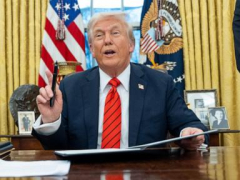WASHINGTON — President Donald Trump plans to on Monday formally announce 25% tariffs on steel and aluminum imports as part of an aggressive effort to remake the existing terms of world trade that so far has compounded economic uncertainty.
Trump also intends this week to reset U.S. taxes on all imports to match the same levels charged by other countries, all of which comes on top of the 10% tariffs he already put on China, China’s retaliatory tariffs that started Monday and the U.S. tariffs planned for Canada and Mexico that have been suspended until March 1.
All of this carries inflation risks at a moment when voters are already weary of high prices and fearful that price increases will eclipse any income gains. Trump maintains that the tariffs will level the playing field in international trade and make U.S. factories more competitive, such that any pain felt by consumers and businesses would eventually be worthwhile.
“’Fairness’ is in the eye of the beholder, but the more fundamental question is whether the U.S. actually benefits from such new tariffs,” Benn Steil, director of international economics at the Council on Foreign Relations, a New York-based nonpartisan think tank, said in an email. “The costs to the U.S. will include higher prices to U.S. consumers, retaliatory tariffs abroad, and the loss of U.S. jobs and competitiveness in firms hit by higher input costs.”
Steil noted that other countries are already adopting Trump’s approach from his first term as the president imposes tariffs on the premise that the imports create national security risks. That’s because national security-related tariffs are legally unchallengeable at the World Trade Organization, meaning that so far Trump’s approach has encouraged other countries to increase trade barriers.
“Not surprisingly, everything from ‘door frames’ to ‘alcoholic beverages’ have of late been subject to new import barriers in the developing world on the grounds of national security,” Steil said.
The White House has yet to fully co





